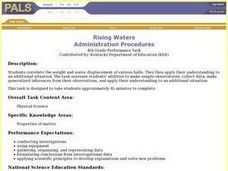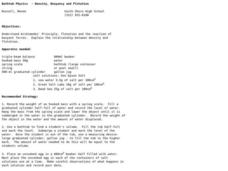Curated OER
Turkey Hunt Obstacle Course
Pupils participate with a fleece ball. Each target can be thrown at only once per round. After the throw the student recovers the ball and moves to the next obstacle. The student puts the fleece ball away, picks up the basketball and...
Curated OER
Density Discoveries
Students participate in Density Discoveries, which is a hands-on learning opportunity for students to find the mass, volume, and density of solid matter.
Curated OER
Tools of the Trade
Third graders explore and identify the tools that can be used to measure length, mass/weight, and volume. They discuss how things are measured using different units, and observe the difference between the English and the Metric systems....
Curated OER
Density Destiny
Sixth graders measure and investigate the densities of several objects. They, in teams, determine the mass and volume of each of the 5 objects and record the measurements in the data table.
Curated OER
Floating Pencil
Students discover how salt water makes a pencil float better than freshwater by measuring and comparing the lengths of the portion of the pencil that floats above the water surface. They then determine if an unknown water sample is...
Curated OER
Rising Waters
Fourth graders rank balls by size from smallest to largest and from lightest to heaviest and then by how much they made the water rise. They then discuss why certain balls make the water rise higher than do other balls.
Curated OER
Colored Dots 1
Learners observe that colored markers are a mixture of many different colors by performing a chromatography experiment. They make observations, record information, and make generalized inferences from their observations.
Curated OER
Plastic Wrap
Students compare the price and quality of different kinds of plastic kitchen wraps and then rank them from best to worst. They take into account how well it comes out of the roll, if it seals well, it is tangles, how much weight it...
Curated OER
Colored Drops
Learners examine the properties of a liquid that contains water and food coloring and a liquid that contains water, food coloring and a liquid detergent. They interpret their data, describe properties, and make reasonable explanations...
Curated OER
Transformations of Energy
Seventh graders investigate the relationship between energy and matter, and measure the mass of various objects. They listen to a teacher-led lecture about potential energy, and in small groups measure the mass of various objects such...
Curated OER
Bathtub Physics - Density, Buoyancy and Flotation
Students study Archimedes' Principle, flotation and the reaction of buoyant forces and explain the relationship between density and flotation.
Curated OER
Testing Density of Various Soap Products
Young scholars have the opportunity to observe, measure and analyze the density of aerosol shaving creams and foams generated from shampoo and dishwashing liquids or detergents.
Curated OER
Solubility
Fifth graders determine the difference between a soluble and an insoluble solution and how to increase solubility. They make a saturated solution using solvents at different temperatures.
Curated OER
Physical/Chemical Properties of a Burning Candle
Students investigate the physical and chemical properties of a candle before and after it is lit. They conduct a burning candle experiment, and complete a KWL chart and worksheet, recording the results of the investigation.
Curated OER
The Average Atom - Isotopes
Seventh graders, in groups, complete an Isotopes model and notice that atomic masses are decimal numbers. These masses are an average of all the isotopes of that element.
Curated OER
Hover Above the Earth
Fourth graders build a balloon hovercraft, take direct measurements, answer critical questions, and make calculations using the data gathered in order to see the concept of acceleration as a change in velocity. They use a worksheet...
Curated OER
Scientific Method "Lab Writeup"
Students analyze and experience the scientific method. They discuss the various steps of the method, conduct various experiments, and write a three-paragraph essay regarding their conclusion.
Curated OER
Project Geode
Learners predict the appearance of a geode's internal structure based on its mass and density. They form a hypothesis based on the data they collect. They also identify common minerals found in Illinois.
Curated OER
Temperature School
Students observ the cooling and warming of room temperature, hot, and ice cold cans of water by measuring the change in temperature over time. They then attempt to develop explanations for the observations made and apply their findings...
Curated OER
Balls and Ramp
Students role several balls of different weights down a ramp and into a paper cup and record how far each ball made the paper cup move. They then answer questions that help them analyze their results and reinforce the idea that energy...
Curated OER
Swingers
Students investigate the motion of a swinging pendulum. They experiment with a pendulum to find out why it might swing at different speeds at different times.
Curated OER
Observing Objects
Learners observe the motion of both a pendulum and a spring pendulum . They then explain the differences and the similarities between the two types of motions.
Curated OER
Interdisciplinary Task: Weather
Learners design a chart to use to record the weather for five days. They then build an anemometer to record wind speed and discover why they are used for this purpose.
Curated OER
More Lizard Snacks
Students listen to Chapter I, Chapter II, Chapter III, and Chapter IV of "The Forgetful Pony". They observe different stages of development of mealworms. The student sequences pictures to show the life cycle and draws the developmental...
Other popular searches
- Triple Beam Balance
- Balance Beam Techniques
- Reading Triple Beam Balance
- Triple Beam Balance Practice
- Using Triple Beam Balance
- Balance Beam Turns
- Balance Beam Games
- Balance Beam Gymnastics
- Balance Beam Measuring
- High School Balance Beam
- Low Balance Beam
- Balance Beam Etymology

























